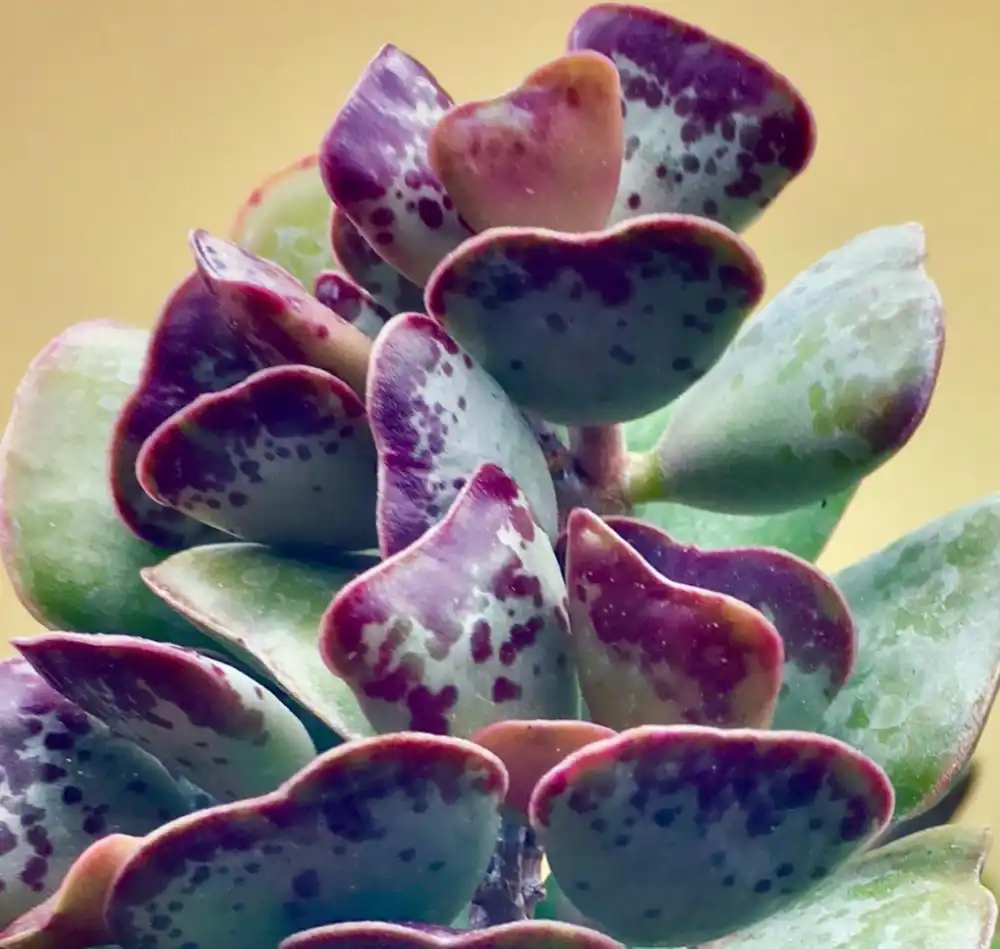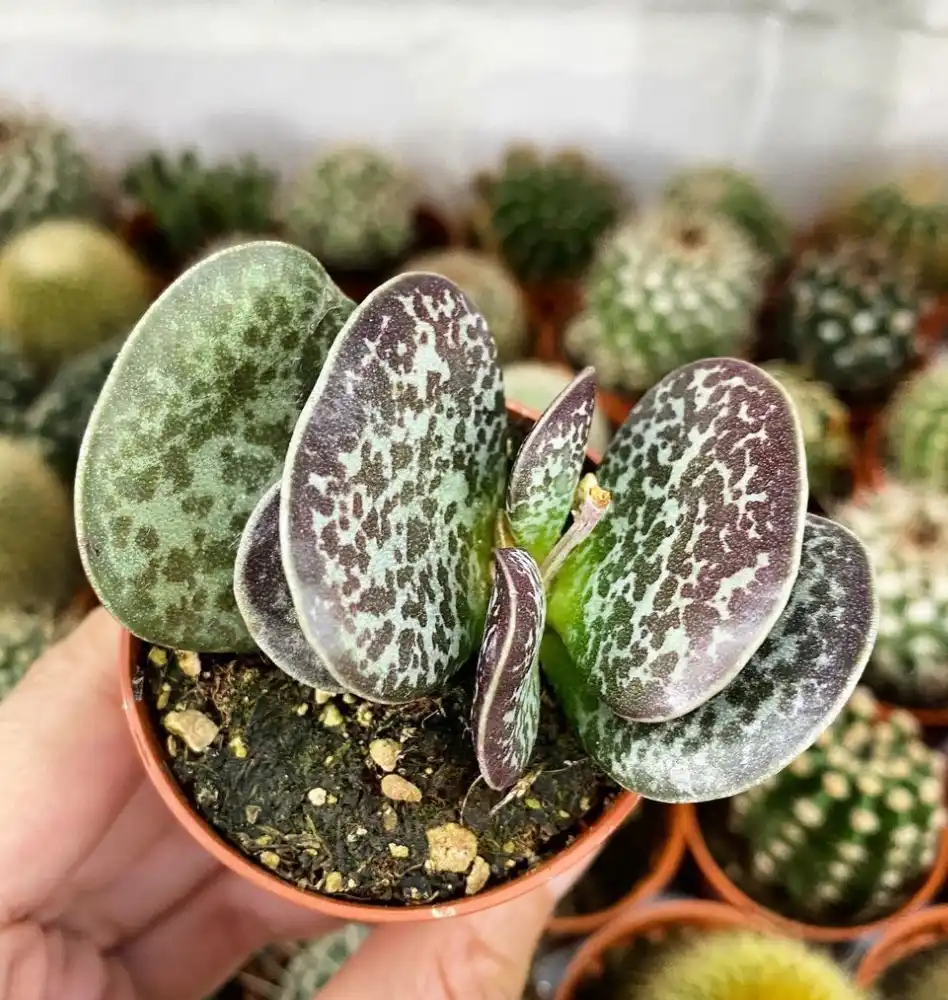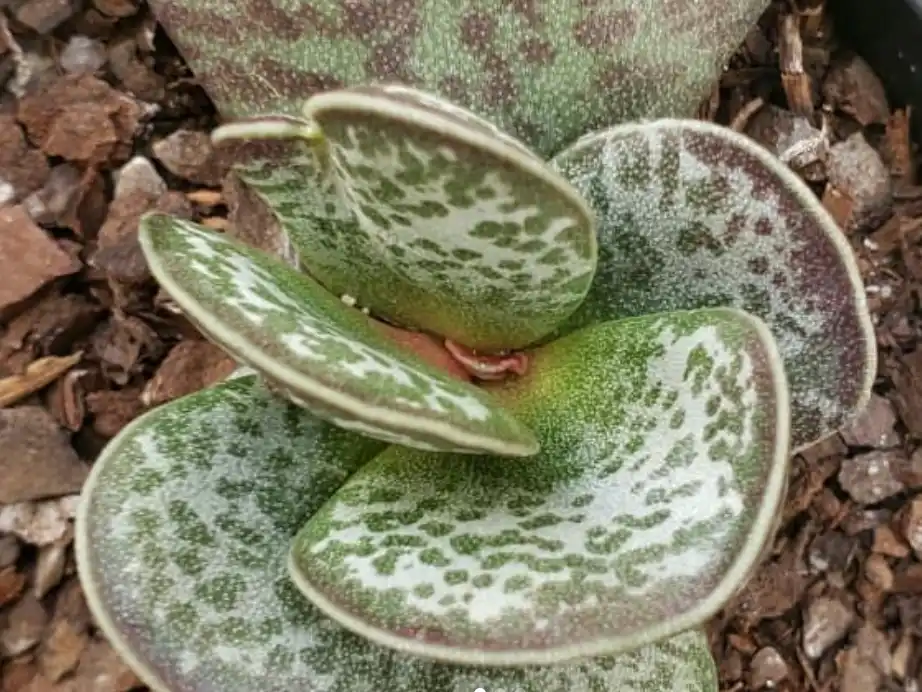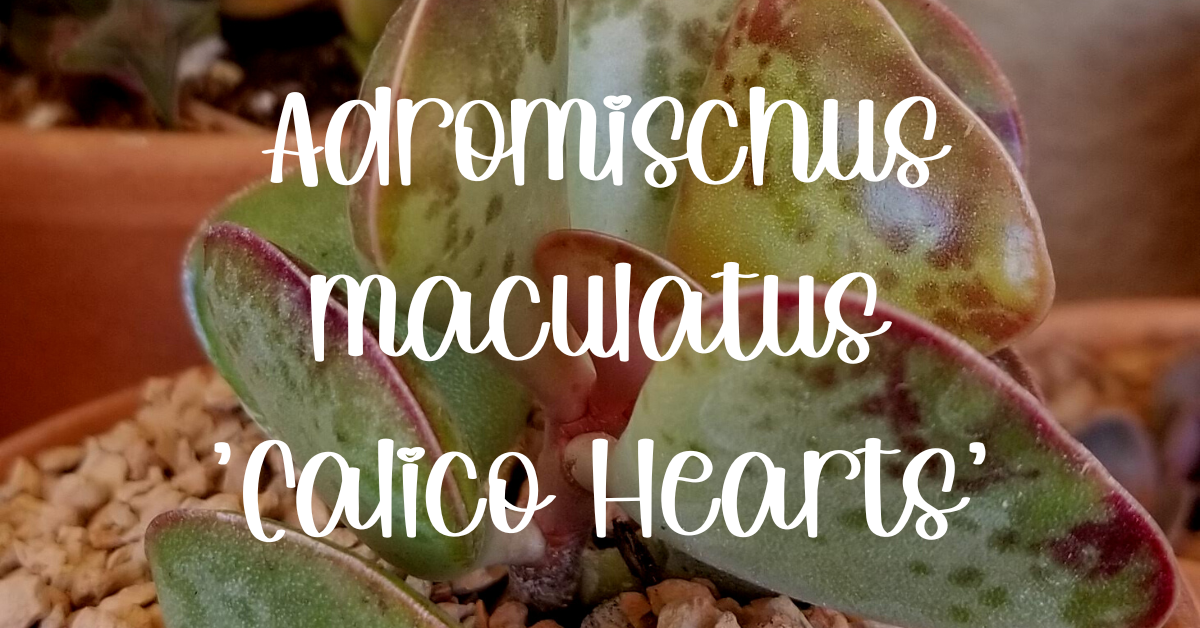Adromischus maculatus ‘Calico Hearts’ is a succulent that is highly valued for its beautiful variegated foliage. The leaves have a striking pattern of green, red, and yellow pigment that resembles the fur of a calico cat. The plant’s name and cultivar status come from this colorful display.

The leaves are oval-shaped, slightly soft in texture, and plump when hydrated. They grow around a main stem and continue to sprout from the center as the plant matures. The rosette gradually widens, elongates, and new offsets often branch out from the main stem, inheriting the same calico coloration as the parent plant. Although Adromischus maculatus ‘Calico Hearts’ produces pale cream flowers, its striking foliage is its main attraction.
Dig in!
How do I water Adromischus maculatus ‘Calico Hearts’?
The most important thing to remember when watering your Adromischus maculatus ‘Calico Hearts’ succulent is to only give it water when it really needs it. Stick your finger about an inch into the soil to check if it’s dry before giving it a drink. During the growing season when it’s active, you’ll probably water once every 1-2 weeks, but maybe even less often depending on the light levels and warmth.

In the fall and winter, Adromischus maculatus ‘Calico Hearts’ will go into a bit of dormancy mode, so you’ll want to cut back to watering maybe once every 3-6 weeks. Always make sure the top few inches of soil are bone dry between waterings. If the soil stays soggy for too long, it can cause root rot which will make your plant really sick. Heck, if there’s any doubt if it needs water, just wait. It’s always easier to water a plant than to fix damage from overwatering.
When you do water, go ahead and pour until water starts flowing out the drainage holes at the bottom of the pot. This ensures the whole root ball is hydrated. Let your Adromischus maculatus ‘Calico Hearts’ sit for a couple hours after watering before putting it back in a sunny spot. This gives it time to absorb it all.

As the weather warms up in spring, you can start slowly increasing your watering frequency and amounts again to match the new growth. This helps the plant adjust to being watered more often. But again, if the soil is ever soggy for too long after watering bails you out, it’s a sign you were too generous with the hose!
The thing is, every Adromischus maculatus ‘Calico Hearts’ is different, so with experience you’ll start to get a feel for when yours really wants a drink. Don’t overthink it—just keep the soil moderately dry and make sure any water you give has a chance to soak in. If you do end up overwatering at some point, just pulling the plant out of the pot to check on the roots will at least give you a better sense of how much or how little to water next time.
What kind of soil does Adromischus maculatus ‘Calico Hearts’ need?
Adromischus maculatus ‘Calico Hearts’ is a plant that needs soil that can drain water well. Its leaves are softer than most other succulents, so too much water can make it sick. That’s why it needs soil that can’t hold too much water.
A good mix of soil for this plant is one with little organic matter, and lots of perlite, pumice, or inorganic grit. This mix will help water drain out of the soil quickly. When you squeeze the soil, it should hold its shape but crumble apart when you let go. If it stays in a ball, it needs more perlite or pumice.
Adromischus maculatus ‘Calico Hearts’ doesn’t need rich soil with lots of nutrients because it doesn’t grow quickly. Too much organic matter in the soil will keep too much water in, which can cause the roots to decay. A mix of soil for cactus is perfect. You only need to fertilize it at half strength during the growing season.
You should consider repotting Adromischus maculatus ‘Calico Hearts’ every two to three years as it grows. When repotting, use fresh soil and choose a container one size bigger than the one it’s in. Old soil can’t drain well and can cause problems.
It’s important to let the top inch of soil dry out between watering. Before watering, stick your finger about an inch into the soil to check if it’s dry. Water the plant until water flows out of the bottom of the pot and don’t water it again until the top layer is dry. It’s better to water it frequently but with a little bit of water each time.
How much light does Adromischus maculatus ‘Calico Hearts’ need?
Adromischus maculatus ‘Calico Hearts’ needs bright light to thrive and produce vibrant foliage. It thrives in direct sunlight through a sunny window or intense indirect light. Medium or low light results in leggy growth as it stretches towards the sun.
Place Adromischus maculatus ‘Calico Hearts’ near a sunny window where it receives several hours of direct light per day. Use grow lights if natural light is lacking, providing at least 6,000 lux of light intensity aimed at the plant.
Rotate and reposition the pot regularly so all leaf sides receive adequate exposure and shade. This enables even growth and the brightest display of patchy pigments.
Maintain high light year-round as growth slows in winter but light is still essential for health. Low light leads to leaf drop, so move or shade the succulent if sunlight increases or decreases dramatically.
Too little light yields elongated leaves while intense light fosters fuller development. Adjust light conditions to strike a balance perfect for your preferences.
Vibrant calico coloring depends on active photosynthesis from well-lit leaves. Maximum light brings out the best color for a striking specimen.
In short, bright light is utterly critical for Adromischus maculatus ‘Calico Hearts’ well-being and stunning presentations. Sunlight through a sunny window or artificial light akin to midday sun are needed. Position, reorient and take further actions as required to provide adequate brightness across all surfaces. With enough light, expect a vision of lush foliage and popping pigments.
How do I propagate Adromischus maculatus ‘Calico Hearts’?
Select healthy offsets or leaves from your established Adromischus maculatus ‘Calico Hearts’ succulent to propagate. The offsets and leaves should have callused over and developed roots before removing from the main plant. This will ensure successful rooting.
- Use a sharp knife, gardening shears or pruning shears to carefully separate the offsets and leaves from the main succulent. Leave some stem attached to the offsets if possible to aid in repotting. Gently twist or cut offsets off at the base.
- Allow the separated pieces to sit out for a day or two until any wounds dry and callused over. This helps prevent disease issues after rooting. Place in a shady spot out of direct sun.
- Fill small pots or starter containers with well-draining rooting medium. A mixture of perlite and peat moss or coir works well for succulents. Ensure the medium is not packed down too tightly.
- Gently dip the base of offsets and leaves in rooting hormone (optional but helps speed propagation). Then place the pieces gently on the rooting medium, leaving space between multiple offsets.
- Place the covered pots in a bright spot out of direct sunlight. A sunny window with some shade works well. Keep the medium moderately damp but not soaking wet. Let it dry slightly between waterings.
- Check for roots in 4 to 8 weeks. Once offsets and leaves develop a healthy root system, remove the plastic cover gradually to harden them off before repotting.
- Carefully remove offsets and leaves from starter containers and repot into well-draining soil in decorative pots. Select pots one size larger for continued growth.
- Place the newly potted succulents in bright light to promote compact growth. Treat them as you would the mother plant with adequate light, water and fertilizer needs.
- Your new Adromischus maculatus ‘Calico Hearts’ succulents can be given as gifts or enjoyed for your own collection! With time, they will develop their own magnificent calico coloring and patternings.
Is Adromischus maculatus ‘Calico Hearts’ poisonous?
Adromischus maculatus is not considered potentially toxic to pets or livestock if accessed. While plants should be kept out of reach of young children and pets as a precaution, the succulent itself poses no poisoning risk. If you’re unsure about the toxicity of any of your plants, visit: https://www.aspca.org/pet-care/animal-poison-control/toxic-and-non-toxic-plants
What are the most common problems Adromischus maculatus ‘Calico Hearts’ has?
Adromischus maculatus ‘Calico Hearts’ is generally an easy succulent to care for, but there are a few common problems it may develop if conditions are not ideal:
Root rot – Excess moisture and poor drainage are the most significant threats. Soil that stays soggy can lead to root rot, causing leaves to wrinkle, drop, and develop brown spots/rot on the stem end. Allowing the soil to dry out between waterings helps prevent this.
Mealybugs – Like many succulents, Calico Hearts can be susceptible to mealybugs. Check leaves and stems regularly for signs of cottony bumps, which are mealybugs feeding. Wipe off with a cotton swab dipped in rubbing alcohol or isopropyl alcohol. Increase airflow and dryness to reduce mealybug favorability.
Spider mites – Excessively dry, dusty conditions promote spider mites which weaken the plant by webbing leaves together and sucking sap. Increase humidity with a humidity tray or pebble tray. Mist occasionally with a spray bottle.
Lack of light – Insufficient light leads to leggy growth, sparse leaf arrangement, and faded variegation. Place in a bright spot, such as near a sunny window. Supplemental lighting may be needed for some.
Overpotting – While repotting as the rosette expands is occasionally needed, frequent potting up in succession leads to root rot due to inability to thoroughly water without soaking the roots. Only increase pot size slightly at each repotting.
Excessive fertilizer – Although Adromischus maculatus ‘Calico Hearts’ benefits from balanced, moderate fertilizer during the active growing season, too much can cause leaf curling, burning and Injury. Never apply at full strength and discontinue in dormancy.
Cold damage – Dormant in winter, Adromischus maculatus ‘Calico Hearts’ is not fully cold hardy. Extreme cold can cause leaf browning, dropping and stem damage. Move potted plants into a warmer area like near a sunny window or use a grow light. Covering provides some protection but drastically reduces light needed for health.
What is the ideal USDA Hardiness Zone and temperature?
- USDA Hardiness Zone: 9-11. Adromischus maculatus ‘Calico Hearts’ is considered hardy in zones 9 through 11. It can survive light freezes but is not fully cold hardy.
- Outdoor temperature range: Daytime highs of 75-95 F / 24-35 C and nighttime lows of 55-75 F / 13-24 C. Adromischus maculatus ‘Calico Hearts’ thrives in warm conditions and can suffer damage in more extreme heat or cold.
- Indoor temperature range: Daytime highs of 75-90 F / 24-32 C and nighttime lows of 65-75 F / 18-24 C. Keeping Adromischus maculatus ‘Calico Hearts’ indoors year-round or during dormancy provides the most stable environment. Fluctuating temperatures can cause leaf drop or other stress.
- Frost tolerance: Adromischus maculatus ‘Calico Hearts’ can tolerate light freezes (around 28 F / -2 C) but is not fully frost hardy. Hard freezes will cause leaf browning, dropping or damage to stems. Moving pots indoors before first frost is recommended.
- Heat tolerance: Prolonged high temperatures over 100 F / 38 C can cause leaf scorching and damage to Adromischus maculatus ‘Calico Hearts’. Providing shade, increasing humidity and allowing soil to moderately dry out helps prevent overheating issues, especially for succulents in direct sunlight.
- Dormancy: Adromischus maculatus ‘Calico Hearts’ enters dormancy in winter, slowing growth but not completely stopping it. While dormant, water sparingly but do not fully dry out. Bright light still benefits health, even with slower growth. Resume normal watering and fertilizing in spring after dormancy ends.
Where did Adromischus maculatus ‘Calico Hearts’ come from?
Adromischus maculatus is indigenous to the western and eastern Cape region of South Africa. It is found in the wild in mountainous areas receiving ample rainfall and sunlight.
Like pops of art, Adromischus maculatus ‘Calico Hearts’ brings a unique visual interest to my outdoor display and inspires a love of the unexpected. Its spotty leaves hold endless fascination, as patterns emerge and evolve subtly over weeks and seasons. Even the smallest offsets and pups develop memorable characteristics of their own. I got mine in a small 2 inch growers pot and it has flourished and grown exponentially.

